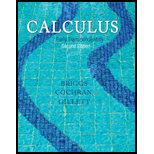
Concept explainers
Solutions to oscillator equations Consider the oscillator equation
a. Find the gain and phase lag functions (see Exercises 5–10).
b. Find the real part of the solution.
c. Graph the forcing function and the real part of the solution. Verify that the gain function and phase lag function are correct.
14. b = 90, ω0 = 100, F0 = 50, ω = 50
Want to see the full answer?
Check out a sample textbook solution
Chapter D2 Solutions
Calculus: Early Transcendentals, 2nd Edition
- Given f(x)=1/x-1 and g(x)=1/x+3, the domain of f(g(x)) in interval notation.arrow_forwardGood Day, Kindly assist with the following query. Regards,arrow_forwardExample 1 Solve the following differential equations: dy dx ex = 3x²-6x+5 dy dx = 4, y(0) = 3 x dy dx 33 = 5x3 +4 Prof. Robdera 5 -10:54 1x ㅁ +arrow_forward
- 21. First-Order Constant-Coefficient Equations. a. Substituting y = ert, find the auxiliary equation for the first-order linear equation ay+by = 0, where a and b are constants with a 0. b. Use the result of part (a) to find the general solution.arrow_forwardLet f be a function whose graph consists of 5 line segments and a semicircle as shown in the figure below. Let g(x) = √ƒƒ(t) dt . 0 3 2 -2 2 4 5 6 7 8 9 10 11 12 13 14 15 1. g(0) = 2. g(2) = 3. g(4) = 4. g(6) = 5. g'(3) = 6. g'(13)=arrow_forwardThe expression 3 | (3+1/+1) of the following integrals? A Ов E + + + + 18 3+1+1 3++1 3++1 (A) √2×14 dx x+1 (C) 1½-½√ √ ² ( 14 ) d x (B) √31dx (D) So 3+x -dx is a Riemann sum approximation of which 5 (E) 1½√√3dx 2x+1arrow_forward
- 2. Suppose the population of Wakanda t years after 2000 is given by the equation f(t) = 45000(1.006). If this trend continues, in what year will the population reach 50,000 people? Show all your work, round your answer to two decimal places, and include units. (4 points)arrow_forward3. Solve the equation, give the answer exactly (no calculator approximations), and show all your work. (4 points) log5 2x = 3arrow_forwardLet I = f(x) dx, where f is the function whose graph is shown. 4 2 y f X 1 2 3 4 (a) Use the graph to find L2, R2 and M2. R₂ M2 = = = (b) Are these underestimates or overestimates of I? O 42 is an underestimate. O 42 is an overestimate. ◇ R2 is an underestimate. OR2 is an overestimate. OM2 is an underestimate. ○ M2 is an overestimate. (c) Use the graph to find T2. T₂ =arrow_forward
- Algebra & Trigonometry with Analytic GeometryAlgebraISBN:9781133382119Author:SwokowskiPublisher:Cengage
